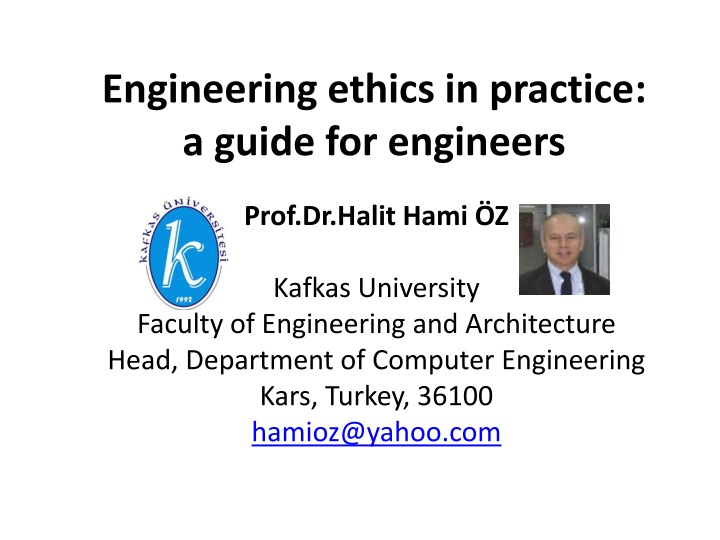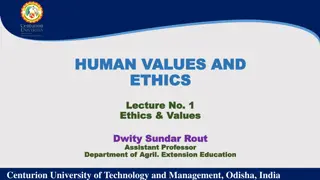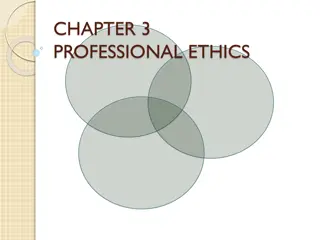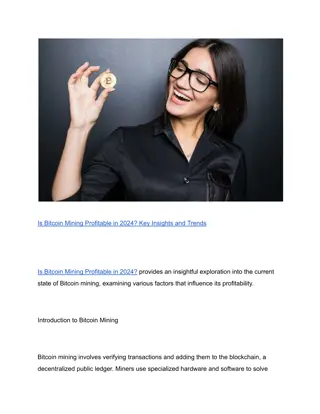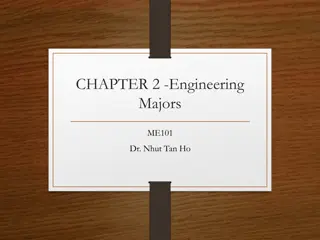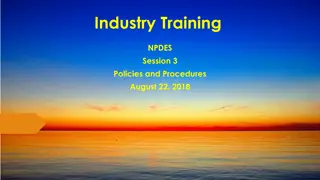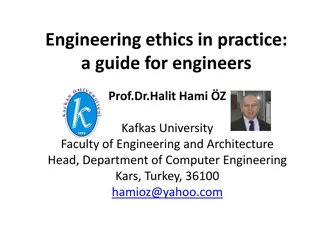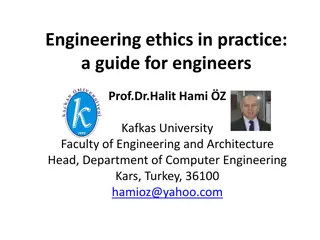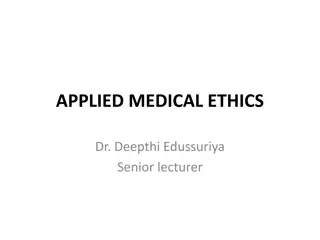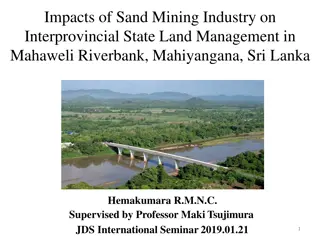Engineering Ethics in Practice: A Guide for Engineers - Dilemma Faced by Corsey Mining
Corsey Mining, a multinational company, faces a dilemma in a new gold mining project where bribery is proposed in exchange for a license. The company must decide whether to uphold ethical standards or pursue the opportunity, balancing profit with integrity in a complex situation.
Download Presentation

Please find below an Image/Link to download the presentation.
The content on the website is provided AS IS for your information and personal use only. It may not be sold, licensed, or shared on other websites without obtaining consent from the author.If you encounter any issues during the download, it is possible that the publisher has removed the file from their server.
You are allowed to download the files provided on this website for personal or commercial use, subject to the condition that they are used lawfully. All files are the property of their respective owners.
The content on the website is provided AS IS for your information and personal use only. It may not be sold, licensed, or shared on other websites without obtaining consent from the author.
E N D
Presentation Transcript
Engineering ethics in practice: a guide for engineers Prof.Dr.Halit Hami Z Kafkas University Faculty of Engineering and Architecture Head, Department of Computer Engineering Kars, Turkey, 36100 hamioz@yahoo.com
I used the Engineering ethics in practice: a guide for engineers book written by The Royal Academy of Engineering for teaching as well as making the ppt presentations about the Engineering Ethics course Prof.Dr.Halit Hami Z Prof.Dr.Halit Hami OZ - Engineering Ethics Course 2
3.3 Rejecting bribery Professional engineers should: reject bribery and improper influence. Scenario Corsey Mining, a large multi-national mining company, is currently setting up new gold mining projects overseas. The company is particularly concerned that it should act responsibly and is looking for opportunities to invest in the local communities which might be affected by its operations. An employee of the company involved in this project becomes aware of some land which they have good reason to believe is very rich in gold. The land is situated in the centre of a country in an area which is currently wilderness. The company begins looking into the possibility of setting up a mining operation there. Prof.Dr.Halit Hami OZ - Engineering Ethics Course 3
3.3 Rejecting bribery Under the law of the country, all companies need to be granted a special license before they can perform any investigative mining activity. Due to the complex local bureaucracy, it proves very difficult to get a clear idea of how to apply for this license, and what criteria the project would have to fulfil in order to be granted it. Prof.Dr.Halit Hami OZ - Engineering Ethics Course 4
3.3 Rejecting bribery After a series of unproductive meetings with local officials, the company are able to arrange a meeting with the Mayor of the local town. Although the Mayor does not make the official application process any clearer, he does make it clear that Corsey Mining would be granted a license if the company agrees to fund the construction of a new hospital for the town. It initially appears that there will be no other way of getting the license. The company express their concerns to the Mayor: they want to be sure that the project is authorised through the proper channels. The Mayor assures Corsey Mining that everything is perfectly above board. In this country, he says, this is the way things are done. Prof.Dr.Halit Hami OZ - Engineering Ethics Course 5
Dilemma You are presented with what looks like an excellent opportunity to set up a prosperous mining operation and also to provide some benefit to a local population. However, in order to get this operation off the ground, it looks like you may have to bypass certain legal channels, and to perform a quid pro quo service for the Mayor which could be interpreted as a bribe. Prof.Dr.Halit Hami OZ - Engineering Ethics Course 6
What should you do? You could go along with the Mayor s suggestion, setting up the mine and building the hospital. You could refuse to go along with the Mayor s suggestion, and look for new opportunities elsewhere. You could continue investigating how to obtain a license for the land. Prof.Dr.Halit Hami OZ - Engineering Ethics Course 7
Discussion The legal situation is important here. Will the Mayor be using his influence improperly to bypass the legal process? Does he in fact have the legal authority to grant you a license? You will need to consider whether the company should make more effort to investigate what the proper channels are, rather than accept the Mayor s reassurance. In this country, this is the way things are done would not be an effective legal defence. Prof.Dr.Halit Hami OZ - Engineering Ethics Course 8
Discussion Your company has a duty to its shareholders to return a profit, so financial considerations will be important. It looks as though your company stands to benefit from a potentially fruitful project. However, can you really trust the Mayor to follow through on his part of the bargain? With little formal paperwork in place, what recompense, legal or otherwise, would you have if he should fail to do so? Prof.Dr.Halit Hami OZ - Engineering Ethics Course 9
Discussion PR and reputational concerns will need to be considered. The opportunity to secure a lucrative mining project while investing in a local community looks superficially like a reputational win-win situation. However, if the legal and ethical status of the Mayor s offer is in question, might you be gambling with the reputation of your company by accepting it? Alternatively, might your company s, and your, reputation be damaged by missing out on a lucrative opportunity? Prof.Dr.Halit Hami OZ - Engineering Ethics Course 10
Discussion If the Mayor is acting legally, and if the proper procedures are followed, then building a hospital for the benefit of the community is unlikely to be seen as a bribe. However, if the Mayor is acting illegally, and is by-passing or wrongly influencing the procedures, or is requiring the hospital for his personal benefit, then the building of the hospital may constitute a bribe, and the mining contract may as a result be deemed illegal and be terminated. Both the company and responsible managers could be liable both for a criminal conviction, and for damages. In addition, you may be committing consequent accounting, tax and money laundering offences. Prof.Dr.Halit Hami OZ - Engineering Ethics Course 11
Discussion You may consider that agreeing to build the hospital would effectively be a bribe to the Mayor. Generally, a bribe is a benefit to the person receiving the bribe that induces them to use official powers in an improper way. In this case, both aspects of this definition can be questioned. Firstly, can the building of a hospital be seen as a personal benefit to the Mayor? Not obviously, although if the Mayor is democratically elected, his securing of a new hospital may well work in his favour in getting re-elected. Secondly, is what the Mayor is suggesting an improper use of his official powers? Prof.Dr.Halit Hami OZ - Engineering Ethics Course 12
Discussion It is important to consider the negative effects of bribery, even though these may not be immediately obvious from the case. In this case, for example, bypassing proper legal channels (if this is what is happening), may result in the bypassing of legal checks and balances designed to minimise impact on the environment, or to ensure that the local people are properly compensated for the loss of land and environmental impact. There is also the possibility that the local people might stand to be exploited. Although they will benefit from the project, perhaps they would have benefited more if the proper legal process had been followed, especially if this had involved a competitive tender between your and another company. So they may be losing out on something to which they are morally entitled Prof.Dr.Halit Hami OZ - Engineering Ethics Course 13
Summary It is important to ensure that your actions are legal, and that no criminal offence is being committed, and no breach of procedures is occurring. It is also important to consider the wider impact of your decisions if you decide to build a hospital, who will staff it, who will provide the resources for it? If it isn t formally supported through legal structures, will the hospital actually do any good for the community? Would the building of the hospital end up being a white elephant nice but useless, and if so, what will this do for your company s reputation? It seems in this situation that it s important at least to try to find another route to carry the mining, possibly through direct engagement with the local communities affected by the project Prof.Dr.Halit Hami OZ - Engineering Ethics Course 14
Other ethical considerations involved in this case This case covers a number of considerations that are relevant to respect forlife, law and the public good: requirements to ensure that work is lawful and justified; that it takes account of the limited availability of natural resources; and that it does not risk the reputation of the engineering profession. In addition, it raises questions of responsible leadershipsince, given the trust placed in engineers by society, they have a duty to take the wider societal good into consideration in deciding on an appropriate course of action. Prof.Dr.Halit Hami OZ - Engineering Ethics Course 15
3.4 Gaining trust Professional engineers should act for each employer or client in a reliable and trustworthy manner Scenario Sudoparts are a multinational company with a reputation for developing innovative and cutting-edge parts for the European automobile market. One of the senior engineers is leading a team working on new designs for transmission systems, and a need has emerged for a new design of constant-velocity (CV) joint. CV joints allow a rotating shaft to transmit power through a variable angle without an increase in friction or play. They are used on the drive shafts that connect the transmission to steered wheels, and have to accommodate both the rotation of the wheels and the vertical motion of the suspension. Prof.Dr.Halit Hami OZ - Engineering Ethics Course 16
3.4 Gaining trust The team is keen to set up an R&D project based around some new design ideas, which will hopefully increase the efficiency of the energy transfer, the senior engineer puts together a proposal to take to the board of Sudoparts. The engineer is aware that it is a difficult time for the company, and that expenditure is being very closely managed. The project will have to be very carefully presented to the board if it is to obtain any funding. The board has made it clear that it will only grant funds for activities that are clearly structured and managed. Prof.Dr.Halit Hami OZ - Engineering Ethics Course 17
3.4 Gaining trust The project is estimated to cost 5m: for staff time, tooling of new machinery, and production and testing of the prototypes. However, often with this kind of project there is a significant risk of further funds being needed. In this kind of R&D work, promising avenues can very quickly become dead-ends, and the team would have to go back to the drawing board. If this kind of thing happens, it is estimated that the project would need up to 1m on top of the original 5m. Prof.Dr.Halit Hami OZ - Engineering Ethics Course 18
3.4 Gaining trust The senior engineer could include the possibility of a further 1m in the presentation to the board, but the prospect of further necessary investment, as well as the appearance of a level of uncertainty, might give the board a reason to block the project. The whole team is very keen to work on this exciting project, and it is necessary that the best possible case is presented to the board. Prof.Dr.Halit Hami OZ - Engineering Ethics Course 19
3.4 Gaining trust If the senior engineer does not mention the possible need for supplementary investment, the board will look much more kindly on the bid although they recognise that development projects tend to be overspent. Nonetheless, in the current circumstances the board would be very unhappy if further funds did turn out to be necessary. Prof.Dr.Halit Hami OZ - Engineering Ethics Course 20
Dilemma As a team leader presenting a bid for R&D funding, you naturally want to present the best possible case for the project that you wish to work on. However, this may mean omitting details about the risk of further funding being needed. Should you disclose this possibility in your presentation? Prof.Dr.Halit Hami OZ - Engineering Ethics Course 21
What should you do? You could lay out every foreseeable cost of the project to the board, including the significant possibility of the need for supplementary funds further down the road. You could omit the risk of further expenditure from the presentation, and express confidence that the project will be completed on budget. Prof.Dr.Halit Hami OZ - Engineering Ethics Course 22
Discussion In a situation in which corporate expenditure is being severely rationed, it might make sense to alter the way in which you present requests for funding. You might want to emphasise certain benefits of the project, and to downplay certain drawbacks that will be particularly worrying to those paying the bills. From this perspective, avoiding mention of the possibility of further expenditure might seem like a viable option. Prof.Dr.Halit Hami OZ - Engineering Ethics Course 23
Discussion You may even feel that the board does not want to be bothered with possible future issues, and that they are looking to you to provide a level of certainty. There may be pressure to deliver results, which might invite a short-term way of thinking. You will have to work within the constraints of your company s way of thinking. Prof.Dr.Halit Hami OZ - Engineering Ethics Course 24
Discussion On the other hand, withholding information about risks associated with the project might conflict with your obligation to present your best engineering judgement. The board will undoubtedly expect you to present the best case you can, but it is probable that this will not include omitting key risks. Prof.Dr.Halit Hami OZ - Engineering Ethics Course 25
Discussion The board will expect you to take a level of personal responsibility for the project. By omitting the risk of extra expenditure you are acting in such a way as to trick the board into agreeing to your request. A more honest way of taking responsibility would be to be upfront about the risks associated with the project, and leave it up to the board to make the final decision. This seems the more appropriate division of labour. Prof.Dr.Halit Hami OZ - Engineering Ethics Course 26
Discussion By presenting all of the information, you would be doing a better job of taking responsibility for all aspects of the proposed project. By limiting your proposal to the positive elements you may not be displaying the sense of responsibility that would be expected given the trust placed in you by your superiors and your colleagues. Prof.Dr.Halit Hami OZ - Engineering Ethics Course 27
Summary You will have to decide in this case what it would mean in practice to act in a reliable and trustworthy manner towards your employer. It is quite clear that telling outright lies would not be acceptable, but equally it seems likely that the board will expect you to put a positive spin on the project and so in doing so you are unlikely to breach your responsibilities. Deciding where spin ends and outright lies begin is a difficult judgment that you will have to make in the light of your knowledge of the organisation, its procedures and the standard expectations of employees. At any rate, it seems improbable that complete failure to mention the possible 1m overrun will be compatible with acting in a trustworthy manner. Prof.Dr.Halit Hami OZ - Engineering Ethics Course 28
Other ethical considerations involved in this case As well as honesty and integrity, this case raises important issues of accuracyand rigour. These issues include the requirements not to mislead others; topresent evidence accurately and without bias; and to identify, evaluate and quantify risks. The requirement to be truthful in a professional capacity is also relevant, bringing with it considerations of responsible leadership. Prof.Dr.Halit Hami OZ - Engineering Ethics Course 29
4 Chapter introduction: Respect for life, law and public good The debate concerning the use of ATP [advanced train protection] on Britain s railways is an ethical dilemma - the system saves lives but the cost is disproportionate compared to using the funds for health or road safety. (Engineering ethics in practice survey) Prof.Dr.Halit Hami OZ - Engineering Ethics Course 30
4 Chapter introduction: Respect for life, law and public good This set of principles is probably the broadest of the four that make up the Statement of Ethical Principles, and arguably the one that encompasses the ethical issues most commonly associated with engineering ethics. Obviously, all of us have general responsibilities for the life, law and the public good, but the engineer also has particular professional responsibilities to protect and uphold these. Many discussions of engineering ethics focus on major accidents where people were killed and injured, and particularly cases in which there seems to have been some level of negligence involved; for example, the Bhopal chemical leak, the Challenger space shuttle disaster and the Piper Alpha offshore rig fire. Prof.Dr.Halit Hami OZ - Engineering Ethics Course 31
4 Chapter introduction: Respect for life, law and public good Indeed, when Michael Davis, a leading ethicist,3 considers the question What does it mean to think like an engineer? his conclusion is that the principle of ensuring the safety of others is so central to engineering that following it constitutes a large part of what is involved in thinking like an engineer. His analysis was based on an investigation of the Challenger disaster, in the course of which the head engineer was apparently asked to think like a manager, and not like an engineer. Prof.Dr.Halit Hami OZ - Engineering Ethics Course 32
4 Chapter introduction: Respect for life, law and public good This set of principles is not limited to health and safety, but also covers respect for the law, respect for (and the protection of) the natural environment, and the reputation and dignity of the engineering profession. It encompasses all aspects of engineers responsibilities for the people affected by their work and the social and environmental context in which they function. This aspect of an engineer s responsibility is very sensitive to changing social and political standards and expectations, and the steps engineers are expected to take to protect others have changed over time, and vary across the world. The risk that labourers on Victorian engineering projects would have been exposed to, such as the building of Brunel s Great Western Railway, where 100 people died blasting one tunnel alone, would not be tolerated now. Similarly, there is increasing awareness of the impact of engineering projects on the local landscape and the global environment, and the need to mitigate any negative impacts Prof.Dr.Halit Hami OZ - Engineering Ethics Course 33
4 Chapter introduction: Respect for life, law and public good These principles overlap significantly with the previous principles because, for example, failures of accuracy and rigour can put the public at risk, and failures of honesty and integrity can damage the reputation of the profession. Furthermore, as the example below illustrates, this principle doesn t only apply to the most senior engineers making decisions at the highest level, but on all engineers, from technicians to managers. Prof.Dr.Halit Hami OZ - Engineering Ethics Course 34
4 Chapter introduction: Respect for life, law and public good James is replacing the window of a commercial passenger aircraft, but realises that he doesn t quite have enough new bolts with the screen he has just over half of the number he needs. The standard practice is usually to throw away old bolts and to refit windows with new bolts provided with the screen. However, time is short, he s due to finish for the day, and he suspects that if he goes to find more bolts there will be delays and he won t be able to finish on time. In addition he ll be late for his date, and he wants to make a good impression. He knows that other members of staff sometimes re-use old bolts when they re short of parts. Is using the old bolts compatible with showing due respect to life, law and the public good? Prof.Dr.Halit Hami OZ - Engineering Ethics Course 35
4 Chapter introduction: Respect for life, law and public good In the following sections, more detailed cases, based on real scenarios, are used to illustrate different aspects of the respect for life, law and the public good. These cases are designed to be challenging, and to allow reflection on what the principle means in practice Prof.Dr.Halit Hami OZ - Engineering Ethics Course 36
4.1 Justifying the work Ensure that all work is lawful and justified Scenario Logic Learning is a small software engineering company specialising in designing and developing e-learning functionality. Having only ten employees, the company relies on a steady flow of public sector contracts to ensure its continued viability. Logic Learning has an excellent reputation in the industry, but its revenue has been hit by cuts in public spending, and as a consequence it has recently posted an annual loss for the first time in ten years of trading. Prof.Dr.Halit Hami OZ - Engineering Ethics Course 37
4.1 Justifying the work A government department has recently set up a new agency whose purpose will be to provide online training for unemployed people. The idea is that this training will help people to develop a range of skills with the overall aim of helping them get back into work. Courses will be developed in all aspects of the job-hunting process, including designing an effective CV, looking for job adverts, filling in job applications, interview technique, and so on. There may also be courses in basic numeracy, literacy and IT skills. Learning Logic has a good pedigree in designing and developing courses of this general kind, and creating a good relationship with the new agency could lead to an excellent ongoing source of income for the company. Prof.Dr.Halit Hami OZ - Engineering Ethics Course 38
4.1 Justifying the work The Managing Director of Logic Learning has a background in software engineering and learning design. She looks over the first Invitation to Tender (ITT) that has been released by the new agency for a course in CV design with a view to developing a bid. The course has eight definite learning outcomes, and the person who has written the ITT has stipulated that each of these learning outcomes should be assessed using a different method of assessment in order to provide variety for the user. In the MD s opinion, however, this amount of variety in assessment is far too complex for a course of this length. Not only will it make assessment less effective overall, it is also likely to result in a learner experience that is annoying and confusing. On the other hand, these are the project requirements as laid out in the ITT, and the increased complexity in the work would mean a larger project that would bring in more money to Logic Learning if they were to be successful in their bid. Prof.Dr.Halit Hami OZ - Engineering Ethics Course 39
Dilemma Imagine you are the Managing Director of Logic Learning. You are planning to tender for some work from a public sector agency an e-learning course aimed at job-seekers. The work as specified in the Invitation to Tender is, in your opinion, unnecessarily complex. On the one hand, your business needs to take on work, and if you do not bid for the work as described it may be less likely that you will win this contract. Moreover, even if you do win it, a less complex project will bring in less revenue. Prof.Dr.Halit Hami OZ - Engineering Ethics Course 40
What should you do? You could bid for the work as described, arguing that it is the responsibility of the customer to set out the project s requirements, and that your responsibility is to generate revenue for your company by fulfilling these requirements. You could develop a bid that contradicted the customer s stated requirements, but that met what you see as their real needs both more effectively and more cheaply. Prof.Dr.Halit Hami OZ - Engineering Ethics Course 41
Discussion The company described in the case study, Logic Learning, has been struggling financially. However, this new ITT is for work that matches Logic Learning s skills and experience, and their generally good reputation as a supplier of e-learning functionality to public sector organisations, Logic Learning would presumably be in a strong position to win the work. The requirements are problematic, but are not so bad that the project cannot be salvaged. For this reason, ignoring the work seems like a poor option. Realistically, the choice is between options 1 to 3 above. Prof.Dr.Halit Hami OZ - Engineering Ethics Course 42
Discussion Aside from any concern for the client, each of these options can be evaluated in terms of the commercial interest of Logic Learning. If Logic Learning decides to bid for the work as described, it may be that they increase their chances of winning the contract, and the value of that contract is likely to be higher. Furthermore, building a good relationship with this government agency now could lead to more work in the future. However, if the badly thought-out requirements result in a bad piece of software and a poor learning experience, Logic Learning s reputation may be tarnished as a result. It may be that a better relationship can be built by being honest about the perceived shortcomings of the ITT. On the other hand, while the customer might appreciate the honesty of stating concerns, they may resent being told that their requirements are badly thought out, and may choose instead to go with a supplier that sees no problem with the work as it is described. Prof.Dr.Halit Hami OZ - Engineering Ethics Course 43
Discussion So far we have only considered what would be in the commercial interests of Logic Learning. While it is legitimate for the Managing Director of Logic Learning to take these interests into account, they are not the only factors which will impact the decision. The Statement of Ethical Principles states that engineers should ensure that all work is justified . Would the design of eight different assessment methods be justified? In terms of the customer s stated requirements, the answer might be yes , but an engineer may consider that a higher standard of justification is needed here, which could be thought of in terms of respect for the public good. It is perhaps not compatible with respect for the public good to use an unnecessarily large amount of public money to design a piece of software that is frustrating for the people using it. Prof.Dr.Halit Hami OZ - Engineering Ethics Course 44
Discussion However, it may not be Logic Learning s place to make this judgment. There is an important question of responsibility in this case. The customer has a responsibility to set out requirements carefully, but if they appear to have failed in this responsibility to an extent, is it the supplier s responsibility to point this out, especially when this course of action may harm their commercial interests? If it is, the third option looks like a way to discharge this responsibility while minimising the risk to the business. Prof.Dr.Halit Hami OZ - Engineering Ethics Course 45
Summary In this case, tendering for the work as described, but including in the tender a section detailing what you see as the cheaper, more effective option, allows you to discharge any responsibility generated by the need to respect the public interest, while giving you a good chance of winning the contract. However, it will require skilful communication to do this in a way that strikes the customer as a helpful, constructive suggestion rather than an intrusion on or criticism of their work. Furthermore, this may not be the end of the ethical issue. What if the customer accepts your bid, but declines the suggestion regarding simpler functionality? Assuming you still thought the complex version was not justified, would you be ethically required to turn down the work? Prof.Dr.Halit Hami OZ - Engineering Ethics Course 46
Other ethical considerations involved in this case As well as justifying the work, this case also highlights issues of honesty andintegrity. Stating your concerns about the way the project is described maybe a requirement of honesty, and it may be seen as an act of integrity to do this even though it might not be in your own interests. The case also requires you to consider how your work affects others, taking account of the effect of your work on the users of the course, and on the public in general, as well as on your own company and your prospective client. There is also a question of gaining trust. Would you be better placed to gain the trust of your client by serving their needs as described, or by stating your reservations about their ITT? Prof.Dr.Halit Hami OZ - Engineering Ethics Course 47
